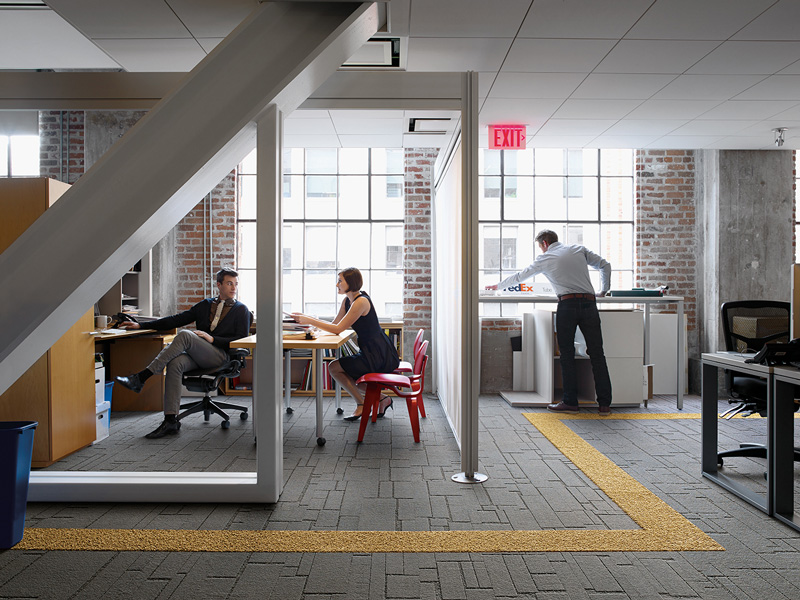How can we design the mindful office? What would a mindful office look and feel like?
An introduction to mindfulness
We live and work in a world full of distracting pollution.
With increased digital connectivity through access to emails, social media, the web’s encyclopedic repository of information and all the other distractions that are commonplace in office environments – other people’s conversations, phones ringing, machines whirring and bleeping and the sound of passing traffic – we are increasingly finding it impossible to focus on the task at hand.

Interface Products: Equal Measure and Human Nature
Professor Gloria Mark, who researches “interruption”, conducted a study of information workers in high-tech companies. She found that the people they observed over 3.5 days switched activities every three minutes and five seconds on average (half of these switches were caused by self-interruptions). In the study she found that relevant interruptions can be beneficial and provided they are short and fairly automatic they won’t cause too much disruption, however if they require a switch in cognitive functioning they can make it difficult to regain focus.
From what she observed, 82% of interrupted work was resumed on the same day. However it took the workers an average of 23 minutes and 15 seconds to return to what they were doing. Surprisingly, those who were interrupted worked faster without any significant difference in the number of errors in the work. However these interruptions have more serious implications as they increase stress levels.
Excessive or prolonged stress can lead to illness, physical and emotional exhaustion and depression. It can affect the behaviours and factors that increase the risk of heart disease (high blood pressure, cholesterol levels, smoking, physical inactivity and overeating). In fact the World Health Organisation believe that the stress related illnesses of heart disease and depression are projected to become the prime causes of illness by 2020.
Considering 90% of a typical business’ operating costs are related to staff (salaries and benefits) as opposed to 10% on the physical environment. It is worth considering how the office environment can be designed to help workers focus on the task at hand and reduce the risk of increasing prolonged stress levels which in the long term will affect both the individuals’ health, their ability to work and the companies’ costs.
Big businesses like Goldman Sachs, Barclays, Google and JP Morgan are now investing in Mindfulness programmes for their staff to address these issues . Mindfulness techniques are also being trialed in schools to help improve students’ performance and experience.
Mindfulness is a technique rooted in Eastern meditation that helps increase awareness of the present moment through regular connection with one’s senses. It has more recently become a tried and tested technique in psychology to reduce stress and anxiety related mental health issues and in other medical professions to address physical disorders.
Mindfulness in the workplace
So how do we create working environments that encourage mindfulness and help employees stay focused on the task at hand? Biophilic design offers opportunities to encourage sensory awareness required for mindful states by appealing to a range of senses:
Sight
Through increasing the amount of natural light & creating views out to nature it’s possible for employees to have greater awareness of the present moment whether that is the time of day or year. Partitions can help in open plan offices, not only do they block visual distraction but if planted or natural material partitions (i.e. timber boards) are used they can also dampen sound and have positive effects on health and wellbeing1.
Smell
Introducing plants can improve air quality2 and increase oxygen level, but also emits a subtle scent by putting pot plants & green planted walls. Other natural aromas can be introduced to help.
Touch
Range of natural surface textures e.g. Timber furniture grain provides haptic stimulation. Interface’s Human Nature and Urban Retreat collections of flooring mimic the varying textures in natural environments and the undulating surface to walk across.
Hearing
Sound masking can be introduced where it is impossible to block out extraneous noise as a method of stress reduction. Recorded sounds like water flowing can effectively mask disruptive noises like passing traffic3 or others’ conversations. In the Heath Design studio we use a service called Focus@will, or listen to Julian Treasure’s “Study” app. Sound insulation – wall panels made from natural materials like wool felt4 – or green walls can absorb excessive sound whilst introducing biophilic natural elements and textures.
Thermoception
Thermoception is the sense by which we perceive temperature, which can be influenced by the feeling of air moving across the skin. Thus, optimising ventilation and thermal control5 to ensure workers can control the temperature and air flow according to their needs (i.e. windows and vents that can be opened when needed and accessible localised thermostats).
With this in mind, the slick shiny surfaces used in minimalist office interiors of the past which were meant to reflect and encourage efficiency actually prove to be less efficient. This is because a lack of sensory stimulation in the workspace can lead us to seek or be susceptible to distractions and to interrupt our work flow.
Have you been distracted in the course of reading this article? Could your surroundings need to become more “mindful”? What is your most powerful mindful space?
1Biophilia: Does Visual Contact with Nature Impact on Health and Well-Being
2Nasa Report (1989) Interior Landscape Plants for Air Pollution Abatement
3Galbrun & T. T. Ali (2012) Perceptual assessment of water sounds for road traffic noise masking
4Oldham, D.J., Egan, C.A. & Cookson, R.D. (2011) Sustainable acoustic absorbers from the biomass. Applied Acoustics. 72: 350-363.
5World Health Organisation (2010) Guidelines for Indoor Air Quality